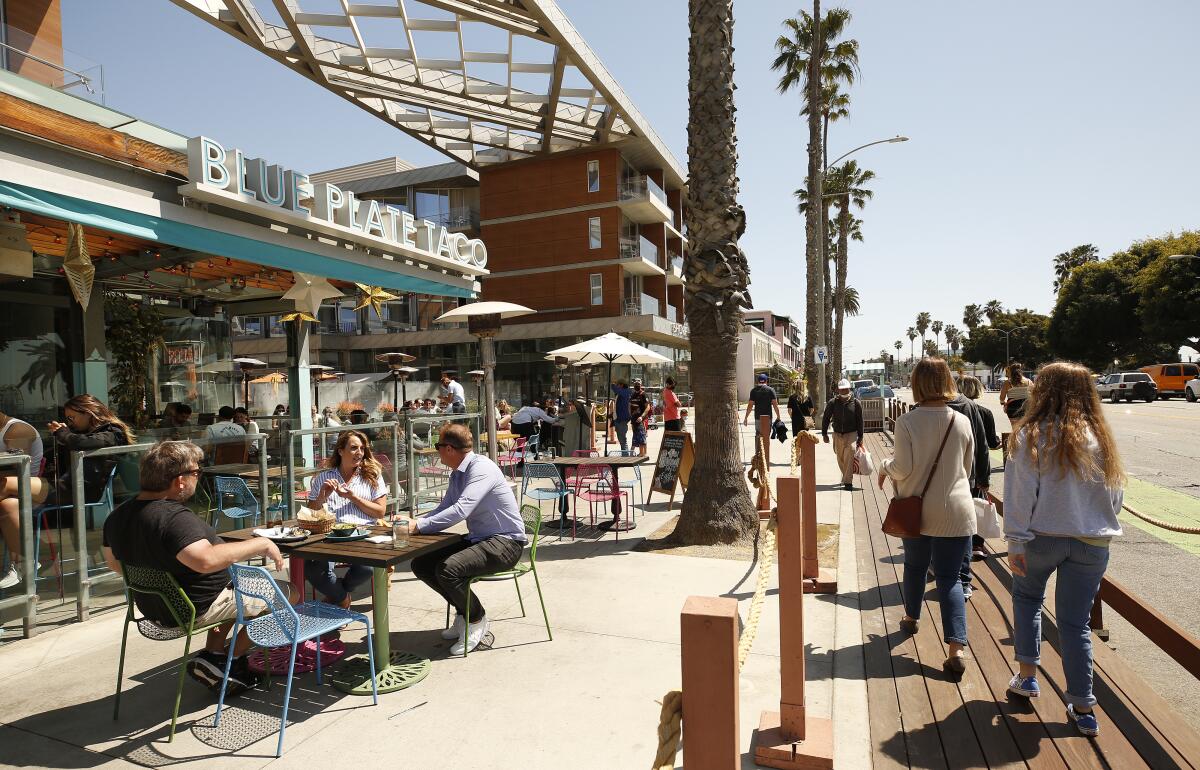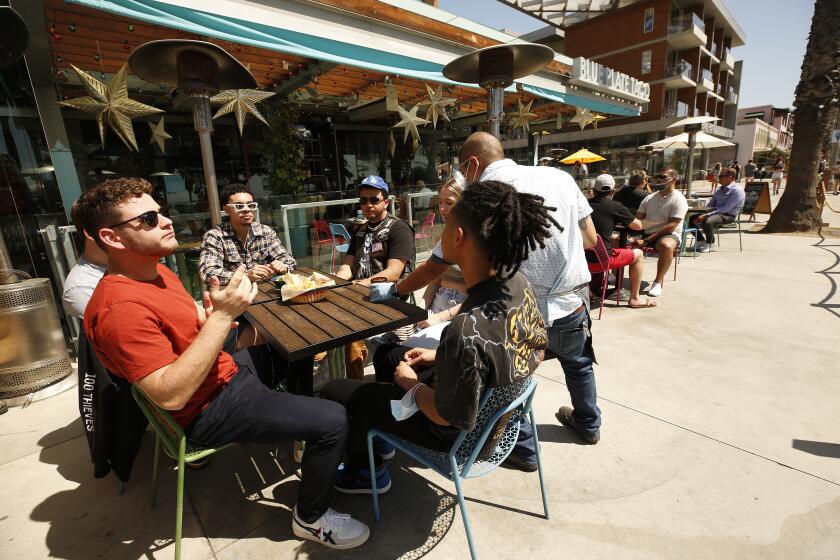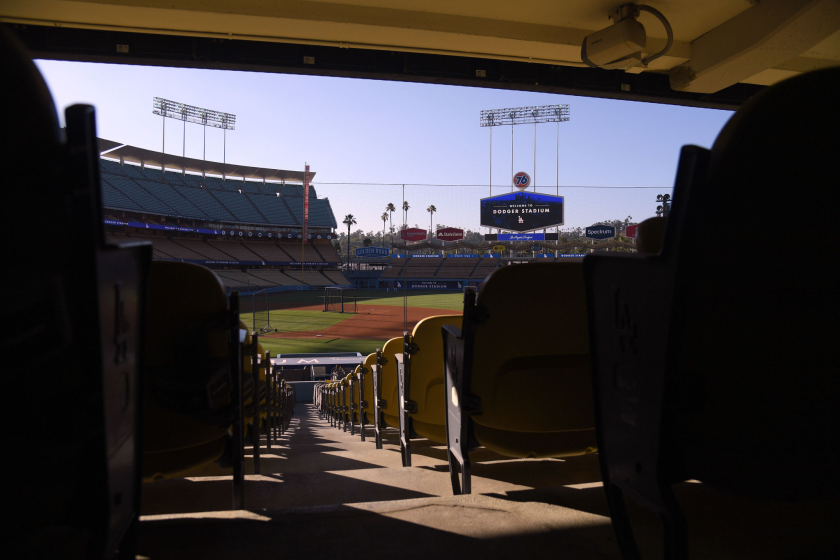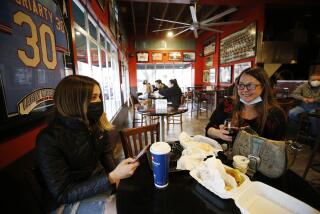L.A., O.C. to hit orange tier: What that means for theme parks, theaters and more

Los Angeles and Orange counties have progressed to the point where they can more widely relax some coronavirus-related restrictions on businesses starting this week, a promising achievement that comes despite growing concerns that parts of the United States could experience a potential spring surge in COVID-19 cases.
According to state data released Tuesday, both counties have hit the benchmarks necessary to progress into California’s orange tier, the second-most-lenient of the state’s four-rung reopening ladder.
L.A. County said the revised health officer order allowing many of the reopenings outlined in the orange tier would go into effect at 12:01 am on April 5. Waiting a bit longer, officials said, gives more time to make sure that the previous red-tier reopenings have not increased coronavirus transmission.
Here are some basic things to know:
L.A. and Orange counties on Wednesday will move into the orange tier in the state’s system for restricting businesses and activities.
So what does orange tier mean?
- Bars can reopen outdoors with some modifications and will no longer be required to also serve food.
- Capacity restrictions can also be lifted in stores, although social distancing and other pandemic safety modifications still apply; houses of worship, museums, zoos and aquariums can raise their indoor capacity from 25% to 50%; restaurants and movie theaters can raise indoor capacity from 25% or 100 people (whichever is fewer) to 50% capacity or 200 people; and indoor gyms and yoga studios increase from 10% to 25%.
- Bowling alleys can reopen with modifications at 25% capacity. Card rooms and satellite wagering sites can also reopen indoors at 25% capacity.
- Offices in nonessential industries can also reopen, though the state says workers should still be encouraged to work remotely.
- Starting Thursday, amusement parks can also reopen at up to 25% capacity in the orange tier.
- Effective that same day, California is also allowing limited fan attendance for outdoor sports and live performances, with the cap set at 33% capacity for counties in the orange tier.
- Retail and grocery stores and libraries can operate at full capacity. Indoor malls’ common areas remain closed, and food courts must operate at a reduced capacity.
With L.A. and Orange counties moving into the orange tier of the coronavirus guidelines, the Dodgers and Angels will be allowed to sell more seats.
How did we get here?
California’s reopening system categorizes counties into one of four tiers based on on three criteria: coronavirus case rates, adjusted based on the number of tests performed; the rate of positive test results; and a health-equity metric intended to ensure that the positive test rate in poorer communities is not significantly higher than the county’s overall figure.
Reaching the orange tier requires a county to have an adjusted rate of 3.9 or fewer new coronavirus cases per 100,000 people each day, a test positivity rate of under 5% and a health equity metric of less than 5.3%.
Counties must meet the required case and testing levels for two consecutive weeks to advance to a less restrictive tier and stay in a tier at least three weeks before advancing again.
L.A. and Orange counties have checked all the necessary boxes for the required two weeks. Their latest adjusted case rates were 3.1 and 2.8, respectively, according to the state.
What would be the next reopening tier?
The next phase would be the yellow tier. To qualify for the category, counties must have fewer than one new case per 100,000 people daily and a coronavirus test positivity rate of less than 2%.
In counties that reach yellow:
- Indoor restaurant dining rooms, movie theaters, houses of worship, gyms, fitness centers, dance and yoga studios, card rooms and satellite wagering sites can open at 50% capacity.
- Wineries, breweries and distilleries can open indoors at 50% capacity or 200 people, whichever is fewer.
- Indoor family entertainment centers, including arcades and ice skating rinks, can reopen at 50% capacity.
- Indoor malls’ common areas can reopen, but food courts must operate at a reduced capacity. Museums, zoos and aquariums can open indoors at full capacity but must follow modifications.
- Breweries and distilleries that don’t serve meals can reopen indoors at 50% capacity.
What about the concerns about a spring surge?
Some experts and public health officials are increasingly alarmed that increases in cases being seen in parts of the U.S. and Europe could eventually threaten California’s progress.
California’s number of average daily coronavirus cases is down 16% over the past two weeks, falling to fewer than 3,000 cases a day. And COVID-19 hospitalizations in California are down 28% from two weeks ago.
Officials have pointed out that, unlike some other states, California has kept a number of coronavirus-related rules — such as a mask mandate — in place. Businesses also are still largely required to modify their operations, such as by reducing capacity, stepping up cleaning and disinfection protocols and reconfiguring seating/queueing areas to ensure physical distancing.
More to Read
Sign up for Essential California
The most important California stories and recommendations in your inbox every morning.
You may occasionally receive promotional content from the Los Angeles Times.














